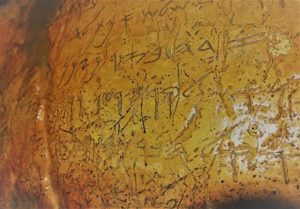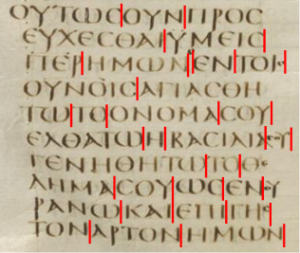The Technology
Technology and the bible
In my previous commentary, we thought about how the books we have in our Bible were selected. We looked especially at the New Testament selection, the ‘canon’ as it is called by scholars. This time we will look at the technology that brought us and still brings us the Bible.
We will take a very broad view of technology, starting with writing itself and ending with the ‘digital revolution’. A few questions to ponder: How did technology affect the bringing or ‘transmission’ of the Bible down through the ages and across the world? How does it affect what we think about it? Does it actually change the Bible itself? Again, our focus will be mainly the New Testament (NT).[1]
Writing
In the last two centuries archaeologists have unearthed much ancient writing. From Mesopotamia come thousands of clay tablets with a cuneiform script (made with a wedge-shaped stylus). While most remain unpublished, great poems, loosely paralleling Biblical accounts, have emerged, such as the Creation and Flood stories, and the epic of Gilgamesh in his search of immortality[2]. The Egyptians developed hieroglyphs, a form of pictorial writing, with abundant examples painted on the walls of royal tombs and written on papyri. Clay tablets found in Crete and southern Greece from the second millennium BCE were brilliantly deciphered in 1952 as primitive Greek in syllabic characters (Linear B)[3], predating alphabetic writing by several hundred years.

The Phoenicians developed an alphabet about the beginning of the first millennium BCE[4], that became with many variations the basis of the Hebrew, Greek and Latin alphabets and by derivation most of today’s Middle Eastern and European alphabets, including English. An outstanding example of an early alphabetic script in Hebrew was found on the wall of the water tunnel King Hezekiah had cut under ancient Jerusalem in anticipation of an Assyrian siege in 701 BCE[5]. It described the amazing engineering experience of the workmen as they met underground tunnelling from opposite ends.
Writing in ancient and medieval times was mostly the preserve of a specialised caste of scribes and priests, who alone could read and write, along with the ruling class and their skilled staff. Through most of history until printing, the great majority of people were illiterate, a fact we too casually overlook. But their memories were better trained than ours[6]. They had to be, there was no mobile phone or internet to fall back on!
Writing materials
So what did they write on? Carving on stone and using baked clay tablets is great for longevity of preservation, but not very practical for personal use. Papyrus (from the Nile valley reed, 2 John v12) and vellum or parchment (dried and treated animal skin, 2 Timothy 413) were the main media for ancient books in the West[7], until the technology of paper making spread from China in the 13th century CE. Personal notes were made on wax, wooden or soft-metal tablets or on ostraca (pieces of broken pottery or sherds)[8]. The letters were formed by carving, scratching or impression or with quill and ink. A little reflection shows how limiting and expensive this technology was for the accurate spread of written materials (scriptures), let alone for personal ownership.
Book production
Written sheets were produced by an individual scribe copying from another manuscript or by a group of scribes writing in response to a reader following a ‘master’ text. Book factories, or scriptoria, were not commonly used by the early Church[9]. Scribes wrote, not at desks, but sitting with the writing material on their legs – the reason the typical width of a manuscript column is 8 to 10 cm. The posture would have been uncomfortable, indoor lighting poor, spectacles and hearing aids unknown and the hours long. Although the general diligence of scribes is acknowledged[10], the opportunities for variations and errors to enter texts transmitted in this way were manifold.
In the 1st century CE, finished sheets were traditionally glued together to form a scroll or book (biblion, Rev 51) about 10 m long. But Christians had moved early (by 200CE) to adopt the new technology of the codex book with leaves sewn on one side[11]. This no doubt facilitated looking up passages of scripture, an incredibly difficult task using a set of long, rolled scrolls. But the expense was great; 50 to 60 sheep or goat skins would have been needed for a bound parchment manuscript of the whole Bible, like the famous Codex Sinaiticus, before allowing for the enormous scribal labour of copying, checking and illuminating the text[12]. The small fortune required would have been beyond the reach of an average Christian household, for whom memory of Scripture would have continued to be the default method of reference.

Until the 9th century, Christian manuscripts were written in capital letters, UNCIALS. The words were not separated and punctuation was minimal. Private as well as public reading was therefore commonly done aloud to aid in the identification of the individual words. Philip heard the Ethiopian eunuch reading Isaiah (Acts 827-30) and 300 years later Augustine showed his surprise on finding Bishop Ambrose of Milan reading silently in private, when he visited him (Confessions 4.3).
The text of the Lord’s Prayer (Mt 69-11a) as it appears in the Codex Sinaiticus manuscript (4th century CE) is shown opposite, with the word divisions imposed on the original in red.
In the 9th century CURSIVE manuscripts, written in lower case “running” writing began to appear. They allowed faster production. But by then so many variations had entered the uncial template manuscripts, that the plethora of these subsequent cursives (5-6,000) contribute little to the task of establishing the original text, the role of textual criticism, which we will consider below.
Review
What were the implications of this technology of the Christian Bible in the first millennium and a half of its existence till the advent of printing? (In the final part of this series we will consider the issue of translation into other languages, including Latin, using both the same and newer technology.)
- Bibles became precious, because Christians believed they contained God’s words, because they were individually crafted and because they were expensive beyond ordinary Christians’ means. Consequently, they were mostly known by memory. And there would have been much variation in the details of wording because of the heavy reliance on memory and the means of transmission. Any idea of ‘inspiration’ precisely at the verbal level would have been problematic.
- Christians were early adopters of new technology, notably the codex book, which has been a major contributor to the advancement of Western civilisation generally. Because the codex book allows non-linear access to a text, in contrast to a scroll or a long inscription carved on a wall, scholarship was unshackled. An early example was the development in the 3rd century of the Eusebian canons or tables, which compared materials in the four canonical gospels. They are still used in today’s printed Greek texts.
- There was enormous ‘fluidity’ in the text arising not only from the technology of transmission, but also because of editing by its religious custodians.
This was not the Bible as we have known it in our lifetimes!
Mass production
The advent in the West of Johannes Gutenberg’s moveable-type printing press in 1439 and the publication of the printed Gutenberg Bible (in Latin) in 1455 heralded a momentous technological advance for civilisation. One uniform publication could now be distributed in vast numbers at relatively low cost. Copyist errors became a thing of the past, unless they were accidentally (or deliberately) incorporated into the printed text, as with the Wicked Bible of 1631, which omitted the negative from the seventh commandment.
From this time pressure began to grow for Bibles to be authorised by both church and civil authorities, examples being the King James Bible (KJV) of 1611 in English and the Luther Bible in German. The Latin Vulgate had long been the underlying standard for Roman Catholics. The tide seems to have turned from increasing ‘fluidity’ towards ‘standardisation’.
The other major consequence was the rapid rise of literacy among the populace. William Tyndale’s wish to put an English Bible in the hands of every ploughboy, echoes the spirit of the times. The use of the Bible among lay people was beginning to move towards the 19th and 20th century experience of every household having and reading a Bible.
Establishing the new testament text
Printing also enhanced the application of scholarship to the Biblical texts in the original languages. Translations of the New Testament into English, German and other European languages were made from a printed Greek text which had been primarily established by Desiderius Erasmus, an esteemed Renaissance scholar. It was published in 1633 as the ‘Received Text´, or Textus Receptus, by the Elzevir publishing house in the Netherlands, with the division into verses, as we now have it, done for the first time by Robert Estienne (Stephanus)[13]. It was effectively the text on which the KJV translation relies.
As impressive as was Erasmus’ scholarship, his text relied on only a handful of ancient manuscripts. Textual criticism since the Enlightenment has been prodigious, especially in recent years. The ‘Received Text’ contrasts with the latest, scholarly ‘received edition’ of the Greek New Testament (Nestle 28)[14], in which over 120 papyri and 280 uncial manuscripts are cited in evidence for the resultant text, most of them many hundreds of years earlier than the manuscripts used by Erasmus.
In its 28 editions across 115 years and building on the inputs of many great researchers[15], the reconstructed Nestle text of the original Greek New Testament represents layer upon layer of research and refinement, leading to the most reliable reconstruction of the originals of any collection of ancient literature in existence. Be clear, however, that we do not possess any of the actual original documents, from the hands of their authors!. The earliest piece discovered to date is a tiny fragment of papyrus copied from John 18, dated about 125 CE, perhaps 30 years after John was written[16].
What does it mean?
The nature of the New Testament documents as Christians have received them, moved over 1400 years towards increasing fluidity as thousands of variations entered the text, partly because of deficiencies of the manual technology and partly as the currents of interpretation influenced their transmission. Since printing, that trend has been reversed, towards ever greater certainty in the reconstruction of the original text.
Another trend has been the huge increase in literacy and the ready availability of written material, including the Bible, in both paper and electronic forms across the world. Now ploughboys/girls in tropical rice paddies can read the New Testament on their mobile phones.
Technology has also seen an explosion of biblical scholarship. More research is now being done on the Bible than in all of previous scholarly history, be it in archaeology, history, culture, linguistics or interpretation. Modern software[17] allows instant access to the analysis of grammar, syntax and interpretation for any passage of the New Testament in the original or translated languages. Contrast this to the handful of literate first Christians who laboriously unrolled a scroll as they read it out aloud to themselves and their illiterate friends, wrestling all the while in their memories to relate it to some other passages of ‘scripture’.
Are these really the same New Testament documents as we receive them? Yes, there were disputes back then (2 Peter 315-16), but over the same minutiae of interpretation which entangle us?
And ironically, as we shall see in the next part of this series on translation, with multiple versions of any passage instantly available to us through digital media, it is now possible to effectively ‘tailor’ or ‘cherry pick’ the translation of a passage to suit our individual tastes. The slow cycle we have seen in the New Testament as we receive it, from fluidity to certainty, may now be swinging back again to greater fluidity. In all of this, where is the Spirit of Truth, who Jesus promised would guide us into all truth (John 1613)?
John Court
[1] An excellent summary of the technology behind the Bible was presented by Prof Pamela Eisenbaum (Iliff School of Theology, Denver, Colorado) in her keynote address to the 4th Common Dreams Conference, Brisbane, September 2016, “The End of the Word as we know it? The Future of Scripture Past”,
http://www.commondreams.org.au/index.php/brisbane-info?id=ARTICLE_61,
[2] Pritchard JB (ed.) 2011 The Ancient Near East: an anthology of texts & pictures (Princeton Univ. Press), Ch 2.
[3] Robinson A 2002 The Man Who Deciphered Linear B: the story of Michael Ventris (Thames & Hudson).
[4] The Gezer Calendar on a limestone tablet is an early example, Prichard p287 & Fig 65.
[5] Pritchard p290 & Fig73. The date is disputed by some. The photo above was taken in the tunnel by the author in June 2015 – standing in running water! It is of a replica of the inscription which is now in the Museum of the Ancient Orient, Istanbul. References: 2 Kings 2020; 2 Chronicles 323-4,30; Isaiah 2211.
[6] Botha PJJ 2012 Orality and Literacy in Early Christianity (Cascade Books), Introduction and Ch 5.
[7] Aland K and Aland B (trans. Rhodes EF) 1989 The Text of the New Testament; an Introduction to the Critical Editions and to the Theory and Practice of Modern Textual Criticism, 2nd ed. (Eerdmans), pp75-77.
[8] Lightfoot, NR 2003 How We Got the Bible, 3rd ed.(Baker), Ch1.
[9] Aland & Aland, p70.
[10] Lightfoot, pp30-31.
[11] Aland & Aland, pp75 & 102; this was a human technological advance as important as the wheel!
[12] Lightfoot, p51 and Aland & Aland, p77.
[13] Aland & Aland, pp 3-6; Lightfoot, pp 106-108.
[14] Aland K & B, Karavidopoulos J, Martini CM and Metzger BM (edd.) 2013 Nestle-Aland: Novum Testamentum Graece 28th ed. (Deutsche Bibelgesellschaft).
[15] K Lachmann, C von Tischendorf, BF Westcott & JA Hort, SP Tregelles, HF von Soden and E Nestle, to name but a few of the prominent forerunners in the discipline.
[16] Aland & Aland, p 85; Lightfoot, pp 122f.
[17] Logos Bible Software, Bibleworks, etc.
oOo

Thank you John Court for your scholarship. My own interests as an historian of ideas overlap. I too get excited about technologies that drive change. I have two questions. 1. What effect did the destruction of Jerusalem have on the writing of the New Testament? 2 What part(s) did special interests (eg clericalism) play in selection and translation of texts? Both questions suggest the pursuits of historical hypotheses to gather corroboration.